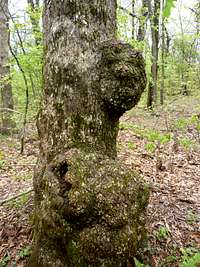-
 14149 Hits
14149 Hits
-
 79.04% Score
79.04% Score
-
 10 Votes
10 Votes
|
|
Mountain/Rock |
|---|---|
|
|
34.66380°N / 84.0731°W |
|
|
Fannin |
|
|
Hiking |
|
|
Spring, Summer, Fall, Winter |
|
|
3640 ft / 1109 m |
|
|
Overview
About 2/3 of a mile as the crow flies northeast of Springer Mountain and west of Big Stamp Gap sits an unassuming, rounded little hill called Ball Mountain. This gentle little mountain requires just a short side-step from the Benton MacKaye trail to reach the top. The wooded summit offers no views, but apparently sees a few visitors: Just south of the top is a bear-gnawed geo-cache canister.
With the exception of a brief bushwack to reach the wooded top, Ball Mountain is a very accessible mountain, as the Benton MacKaye trail traverses the southern slope about midway between County Road 193 / FS 42 and the Appalachian Trail north of Springer Mountain. The mountain makes a nice addition for day-hikers seeking the summit of Springer Mountain, a decent drop-packs leg stretcher for AT-back packers or a pleasant afternoon stroll for campers staying at the Springer Mountain shelter.
USGS Quad: Noontootla
Trails Illustrated Map: #777 Springer & Cohutta Mountains
Rank: Unranked
Prominence: 212 feet
Rank & Prominence Source: Lists of John
Getting There & Route Information
Ball Mountain is about 2/3 of a mile from the intersection of the Appalachain Trail and the Benton MacKaye trail just north of Springer Mountain. Note: These two trails intersect one another several times in this vicinity. From the trail junction just north of the Springer Mountain shelter, follow the Benton MacKaye trail to the east, descending first into an un-named gap before regaining elevation on the west slope of Ball Mountain. The Benton MacKaye trail does not reach the summit of Ball Mountain. A short bushwack from the trail up the southern slope (where the timber, brush, tics and copperhead nests are less dense) of the hill will carry you to the summit.
Special Reminder: There are numerous natural hazards in the southern Appalachian Mountains and going off-trail can put you very much in touch with these icons of regional character. These mountains look soft and gentle to the casual observer, but poison ivy, venomous snakes, ticks, nettles, millipedes, briars, mosquitoes and plenty of other things that can bring harm to the hiker make your visit much more exciting.
Red Tape
Ball Mountain sits within the 23,000 acre Ed Jenkins National Recreation Area in the Chattahoochee National Forest. Practice Leave no Trace backcountry methods and heed Forest Service warnings, notices and closures (regarding bears, campfires and travel).Camping & Lodging
AT Approach Trail Backpacking The nearest trail shelter to Ball Mountain is the Springer Mountain Shelter, about 1 mile away from the top of Ball Mountain.
Len Foote Hike Inn This 20-room eco lodge provides small rooms with one 2-level bunk bed (adjoining rooms available), a clean bathhouse with running water and composting toilets, several comfortable common/social areas (inside and out) and delightful meals cooked by talented staff. Visit this site (www.hike-inn.com) to learn more.
Amicalola Falls State Park Lodge: The Georgia Department of Natural Resources hosts a 56-room lodge within Amicalola Falls State Park. Visit this site (http://www.amicalolafalls.com/) for more details.
Dahlonega: A decent variety of lodging options can be found in nearby Dahlonega, GA, about 19 miles from the Amacalola Falls State Park entrance. Visit this Trip Advisor page for details.
Dawsonville Dawsonville, Georgia, is only 16 miles away from the entrance to Amacalola Falls State Park. Visit this Trip Advisor page for details.
Weather & Seasons
Spring and Fall are considered by many the most pleasant time to visit the Southern Appalachians.
Spring: In the Spring, daytime temperatures and warm and evenings are cool while the flowering shrubs are in bloom and the waterfalls are running. Water sources such as springs are most reliable this time of year.
Fall: In the fall, the broadleaf deciduous trees put on a bright display of autumn color, though waterfalls may not be as impressive and springs and other water sources less reliable. The air is cooler and crisper and visibility should be prime for long-range views.
Summer: Summers in this part of the country can be oppressively hot and humid and even the higher elevation and ample tree cover will not keep the hiker from feeling overheated, sticky and dirty. High humidity and haze mean limited long-range vistas, though it is in summer that the term “temperate rainforest” will have the most meaning to the visitor.
Winter: Winter in the South Appalachians can range from cool and damp to cold and severe with bouts of deep snow following major storms. In other words, while this range may be relatively low in elevation and southern in latitude, mountains are still mountains and can bring unpredictable and potentially dangerous weather.





